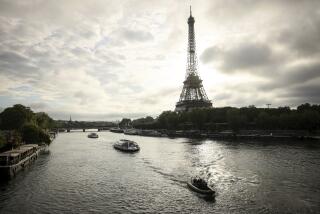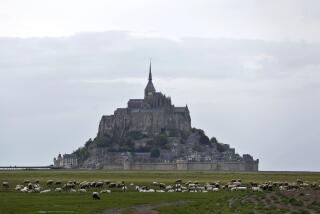Turning the Tide at Mont St. Michel
- Share via
MONT ST. MICHEL, France — While much of the world worries about how to stop sea levels from rising, engineers in this corner of France want to spend $260 million to do just the opposite: raise the tides to preserve the environs of a national treasure.
With its Gothic abbey soaring 558 feet above a mostly flat, nondescript Normandy landscape, Mont St. Michel is both a feat of human will and a quirk of nature, planted in a tidal system that each day brings the sea surging in as fast as a trotting horse to fill the bay with surf.
But Mont St. Michel is no longer much of an island: Since the 19th century, a causeway from the mainland has been disrupting the currents that flush away silt, and about 60 acres of salt marsh are gaining on the islet annually.
“If we do nothing, Mont St. Michel will be surrounded by grass in 2042,” said Francois-Xavier de Beaulaincourt, the engineer overseeing the state-financed project to undo the damage. If the government gives a green light, major work is to start in a few months.
The project aims to be gentle with the bay’s unique ecosystem. A new reservoir will be built on a river to boost its flushing power without affecting the seals, amphibians and shellfish that live here. A new dam with eight sluice gates will also help guide sediment downstream. The Mont will stay open to tourists during work, scheduled to end in 2009.
The causeway and its ugly parking lot will be ripped up. Visitors will park inland and take a shuttle or walk across a delicate new bridge that will let water pass underneath.
By 2042, scientists say, the seabed should lie more than two feet deeper, with tides swirling freely again.
About 1,300 years ago, a bishop built the first small chapel on Mont St. Michel after dreaming that the Archangel Michael told him to do so. The church, abbey and other buildings followed. Over the centuries, pilgrims have trekked to the island shrine from across Europe, risking their lives along the final stretches of quicksand.
The abbey has survived fires, tidal waves and attempted invasions. During the French Revolution, it was converted into a prison and its Benedictine monks banished -- prompting a campaign to save the Mont. Comparing it to the wonders of ancient Egypt, Victor Hugo wrote: “Mont St. Michel appears like something sublime, a marvelous pyramid.”
It is France’s biggest tourist destination after the Eiffel Tower and the Versailles Palace, drawing 3 million visitors a year, and the save-the-Mont plan has naturally stirred passions.
Bay tour guides, trained to navigate surf and quicksand, fret about unforeseen consequences of tampering with the tides. They worry the bay will fill with pockets of water, making it impossible to hike through.
“They want to sacrifice the bay for the sake of Mont St. Michel,” said guide Stephane Gueno, who fell in love with the region’s nature as a child. “They’re thinking mainly of mass tourism.”
Proponents say fears of pooling water are unjustified. To ensure the plan will work, scientists built a 9,700-square-foot scale model in a hangar. Using data from 1975, they simulated 22 years of tide movements until the model matched up with the bay as it was in 1997. Then, sure the model was accurate, they tested ways to reroute the water.
De Beaulaincourt, the project manager, acknowledges no one can foresee the long-term consequences.
“We have a very precise idea of what will happen 50 years after construction, and a good idea of what will happen this century,” he said. “But after that, there are parameters we can’t master. Could there be a global warming that would raise the level of the sea, for example?”
Managers also face questions about the price tag, which has tripled from the estimate of $89 million a decade ago, delaying government approval.
But Mont St. Michel Mayor Patrick Gaulois, whose office overlooks the bay and grassy marshes where sheep graze, says he can’t imagine the Mont surrounded by grass.
“There’s a kind of magic in this place, to see the abbey in the middle of the sea,” Gaulois said. “It has outlasted 1,000 years of storms, and I tell myself, it’s indestructible; nothing can happen to it.”
More to Read
Sign up for The Wild
We’ll help you find the best places to hike, bike and run, as well as the perfect silent spots for meditation and yoga.
You may occasionally receive promotional content from the Los Angeles Times.






